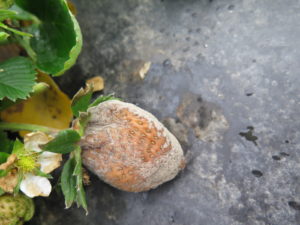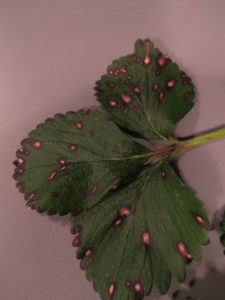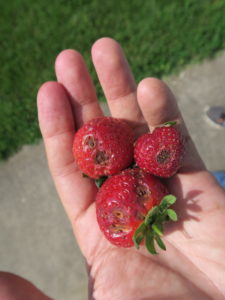At the Southwest Purdue Ag Center, we are studying annual strawberry production on plastic mulch. Our hope is to gather information on the best methods and varieties to use for annual strawberry production in Indiana. As we learn about insect and disease problems, we will pass this information on to producers. This article is about the diseases we have observed in our strawberries which were planted in March 2019.
Strawberry leaf spot-Lesions on leaves start out purple. As the lesions enlarge, the center becomes gray-brown (Figure 1). Under rainy conditions, lesions may coalesce across leaves and cause large necrotic areas. Lesions on stems and petioles may cause dieback. Yield or fruit quality loss can be caused by leaf spot under severe conditions. Although leaf spot symptoms are spread throughout our trial, this disease has not become serious for us.
There are several cultural methods of managing leaf spot. Host resistance or incomplete resistance to leaf spot exists in several strawberry varieties. Since leaf wetness is necessary to initiate leaf spot, avoid overhead irrigation and plant strawberries at the proper spacing so that there is plenty of airflow between plants and rows. If annual culture is used, crop rotation will help to lessen the severity of this disease. Fungicides may not be necessary for management; however, several fungicides are listed in the Midwest Fruit Pest Management Guide 2019-2020.
Botrytis fruit rot/gray mold-Whereas leaf spot affects fruit only indirectly, Botrytis fruit rot affects fruit directly. Symptoms include the rot of fruit and the production of a gray mold over the surface of the fruit (Figure 2). Blossoms may also be affected.

Figure 2. Strawberry fruit or gray mold causes a rot of the fruit often with the appearance of gray mold.
Gray mold is favored by rain fall and high humidity. In fact, we have observed this disease in high tunnel situations where there is no rainfall. Since gray mold can affect many different crops, crop rotation may not be very effective for this disease. Although there are no resistant varieties, cultivars with an upright growth habit may be less severely affected. Plants spaced adequately will have better airflow and less humid conditions. There are a few fungicides listed in the Midwest Fruit Pest Management Guide, however, the most critical time for control is during bloom. Sanitation, that is proper disposal of old leaves and fruit, is more important for perennial strawberry production than for annual production.
Anthracnose-This disease is the most serious disease problem we have faced this year. The most common symptom is sunken lesions on fruit (Figure 3). Occasionally, the lesions can cover a significant portion of the fruit. The lesions can be a pink or salmon color during wet conditions due to the color of the spores. Under severe conditions, lesions can occur on the stem or crowns. However, in our trials, we have only observed fruit symptoms.
Warm, wet weather favors this disease; rain can splash the spores from plant to plant. Therefore, avoid overhead irrigation. The fungus that causes anthracnose of strawberry is related to but different from the anthracnose fungi that cause anthracnose of, for example, tomato or watermelon; crop rotation will help to lessen disease symptoms. Planting materials may harbor the disease, fungicides for control of anthracnose may be applied through pre-plant dip or foliar application. Several fungicides are listed in the Midwest Fruit Pest Management Guide.
The Midwest Fruit Pest Management Guide noted earlier has many resources. Note that there is a table for cultivar resistance on page 118 (information for leaf spot varieties are listed) and a table for fungicide effectiveness on page 119. When selecting products, be sure to keep track of which products are recommended pre-bloom, post-bloom and harvest. Once harvest has started, note preharvest intervals.
Strawberry production can be a profitable venture. Keeping track of disease will help to maintain yields and fruit quality.

